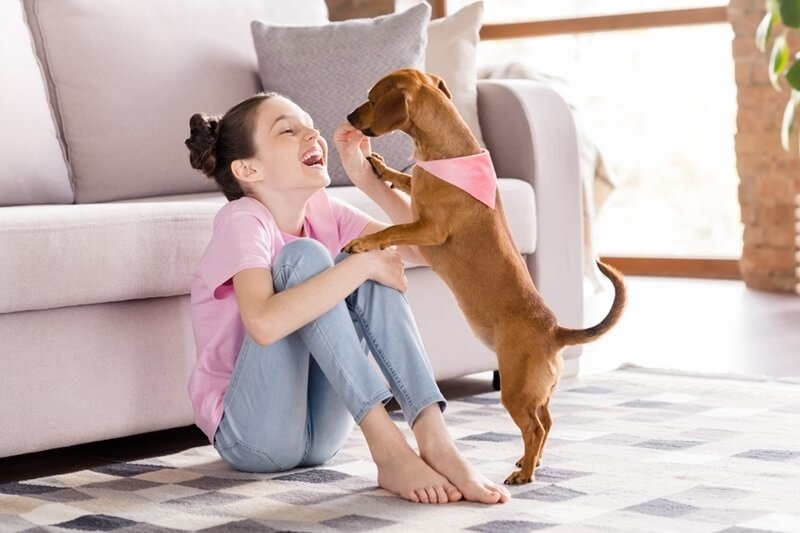
Dachshunds are tiny dogs with huge personalities. Some call them wiener dogs, sausage dogs, doxies—whatever the name, they’re unforgettable. That long body, those determined little legs, and a face that always looks like it’s plotting something. But here’s the catch: owning one is more than enjoying the cuteness. It’s about learning their quirks, their health risks, and how to live with a dog that’s both cuddly and stubborn in equal measure.
If you’ve just welcomed one into your home, or you’re still on the fence, this guide dives into what makes them special, what makes them challenging, and what daily life with a dachshund actually looks like.
Sure, their look is iconic, but dachshund breed characteristics go deeper than shape. They were bred in Germany to hunt badgers—yes, badgers. That explains the bravery, the digging obsession, and the “I’m not afraid of anything” attitude. They’re bold, curious, affectionate, and sometimes, let’s be honest, a little bossy.
They’re loyal companions, but also independent thinkers. That independence? Some people call it stubbornness. Don’t expect them to obey instantly just because you asked nicely. And the barking—oh, the barking. They’ve got a lot to say about squirrels, visitors, or sometimes nothing at all.
That unique silhouette is their trademark, but it’s also their weak spot. Dachshund long body care is something owners must take seriously. Their spines are prone to intervertebral disc disease (IVDD), which can cause pain or even paralysis.
So, what does that mean for everyday life? No leaping off couches like superheroes. Ramps or stairs for furniture are a must. Keep their weight under control—an overweight dachshund is asking for back problems. Even play needs to be thoughtful. Tug-of-war on the floor is fine, but marathon jumping sessions? Not so much.
It might sound like extra work, but it’s really just building habits. Once you do, it becomes second nature.

Parents often ask: can you trust a dachshund with children? The answer is: it depends. Dachshunds can be great family dogs—playful, affectionate, loyal—but they’re not always tolerant of rough play. A toddler pulling an ear or grabbing a tail can push a dachshund’s patience too far.
The best setup is teaching kids to respect boundaries. No grabbing, no climbing, no treating the dog like a toy. In return, you’ll get a devoted little shadow who tags along with the kids’ adventures. Early socialization makes a big difference, so introduce them gently from puppyhood if you can.
Here’s the blunt truth: training a dachshund isn’t always easy. Dachshund training challenges mostly come down to that streak of independence. They were bred to make decisions underground, so they’re not naturally wired to wait for instructions.
House training? Expect it to take a while. Recall? Sometimes they hear you, sometimes they don’t. The trick is consistency, patience, and keeping sessions short and fun. They respond well to treats and praise, not force. Get harsh, and you’ll lose their trust.
If you expect perfection, you’ll end up frustrated. If you go in knowing it’s about teamwork, you’ll discover they’re smart, funny, and surprisingly eager when they feel like they’re in on the game.
So, are they right for you? Thinking about dachshund lifestyle fit is crucial. These dogs need to be part of the action. They don’t thrive in homes where they’re left alone all day. Loneliness can make them anxious, and anxious dachshunds can chew, dig, and bark like there’s no tomorrow.
They need exercise, but not hours of running. A couple of good walks and some playtime indoors usually do the trick. They fit well in apartments if you can handle the barking. But if you want a quiet, low-maintenance dog, this probably isn’t the breed. Dachshunds have opinions, and they’ll make sure you hear them.
What about multi-pet households? Dachshund living with other pets can be a mixed bag. Thanks to their hunting background, small animals like rabbits or hamsters aren’t always safe around them. Cats can go either way—some dachshunds love them, some see them as fun to chase.
With other dogs, they often do well, though don’t be surprised if your dachshund tries to boss around a dog three times its size. Slow introductions and supervision are key. Many do adapt beautifully, but it’s all about personality and training.
Depending on the coat type, grooming can be a breeze or a bigger job. Smooth-coat dachshunds are low maintenance—just a quick brush now and then. Long-haired need more attention to avoid tangles, while wire-haired benefit from stripping or trimming.
No matter the coat, dental care is non-negotiable. Small dogs are prone to dental issues, and dachshunds are no exception. Regular brushing or dental chews will save you future headaches.
Don’t be fooled by their size—dachshunds have energy to burn. Daily walks are a must. More importantly, their brains need exercise too. They love scent games, puzzle feeders, or even just digging in a sandbox.
Without mental stimulation, you’ll hear about it. Barking, chewing, and digging under the fence are classic signs of boredom. Short legs don’t mean short drive.
Besides back issues, dachshunds face risks of obesity, heart conditions, and dental problems. A balanced diet and regular vet checks go a long way. Watch for stiffness, reluctance to move, or sudden crying—these can be red flags for spinal trouble.
Being proactive with their care isn’t optional. It’s what keeps them moving happily through life.
A few daily habits make a world of difference:
Most importantly: give them time and attention. Dachshunds are people dogs. They want to be with you, involved in whatever you’re doing, from cooking dinner to binge-watching TV.
Yes, they bark. Yes, they’re stubborn. But they’re also hilarious, affectionate, and loyal to the bone. They’ll curl up in your lap, make you laugh with their antics, and guard your home like they’re ten times their size. Living with a dachshund is never boring.
Owning a dachshund means embracing quirks as much as charm. Knowing dachshund breed characteristics helps you prepare for the challenges and appreciate the rewards.
They’ll test your patience, they’ll need extra spine care, but in return, they’ll give you loyalty, laughter, and love. If you’re willing to meet them halfway—ramps, patience, and lots of attention—you’ll find yourself with one of the most unforgettable companions out there.
This content was created by AI